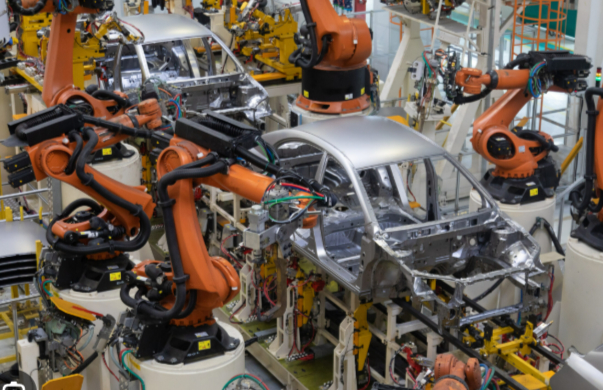Dealerships experienced a surge of buyers in March as consumers rushed to purchase vehicles before potential price increases due to tariffs.
The strong sales in March compensated for a sluggish beginning to the year. Ford announced on Tuesday that its sales in March increased by 10%, bouncing back from a 1.3% decline in total sales for the first quarter. The most significant rise was in retail sales, which soared by 19% in March.
This surge in sales coincides with the Trump administration’s plan to implement a 25% tariff on all vehicles imported from foreign countries, including Canada and Mexico, with intentions to introduce tariffs on auto parts later this year. Such measures could elevate costs for car manufacturers. Approximately half of the vehicles sold in the US market are imports, and vehicles assembled in American factories incorporate a considerable amount of imported parts.
Experts indicate that these factors, combined with a constrained vehicle supply, might lead to an increase in car prices shortly. As a result, consumers have been hurrying to dealerships in recent days to avoid any possible price hikes.
Cox Automotive reported that online traffic to both its Kelley Blue Book and Autotrader.com sites surged by 30% between last Wednesday—when the tariffs were announced—and Monday, compared to the same timeframe a year prior. The websites operated by Cox Automotive for numerous dealerships nationwide saw an average traffic increase of 20%.
“It’s challenging to identify a specific reason for the sales surge in March,” commented Ford spokesperson Said Deep, noting that tariffs weren’t mentioned in the sales announcement.
While most of Ford’s vehicles are manufactured at US plants that won’t face immediate tariff impacts, some of the brand’s most popular models in the quarter are produced outside of the United States.
This includes the Maverick small pickup truck, manufactured in Mexico, which enjoyed a record-breaking sales month in March, moving 19,000 trucks. The company credited the strong sales of the Maverick to “better availability.” The Ford Mustang Mach-E, its electric SUV also made in Mexico, saw a 21% increase in quarter sales compared to the previous year.
Ford estimates that overall new car sales in the US rose by 5% in March, mirroring the sales growth seen in January when the Trump administration initially announced its plans for tariffs on imports from Canada and Mexico, which were subsequently postponed.
Ford is not the only car manufacturer experiencing a sales boost in March.
Toyota reported an almost 8% increase in sales last month after a 3% dip during the first two months of the year.
Honda announced a 13% rise in its March sales compared to a year earlier, following a relatively stable performance in the first two months of 2025. The South Korean automaker Hyundai announced record US sales in March, showing a 13% increase compared to an 8% increase during the first two months of the year.
General Motors stated that its sales increased by nearly 17% for the quarter, although it did not specify how much of that growth occurred in March. It also experienced increased sales for certain models sourced from Mexico and South Korea.
All five automakers noted robust sales of electric vehicles during the quarter. This comes amid uncertainties surrounding the $7,500 tax credit for buyers of many EV models, which is threatened by the Trump administration’s intention to eliminate support for electric vehicles in favor of gasoline-powered ones.
Most major automakers are scheduled to announce their US sales for the first quarter or for March later on Tuesday.
Auto tariffs are just one aspect of the broader tariff initiatives being introduced this week by the Trump administration. On Wednesday, President Trump is expected to reveal his plans for reciprocal tariffs from the Rose Garden, according to a White House announcement on Tuesday, though the details remain undecided.
Trump doesn’t seem to understand how car prices work
President Donald Trump claims he “couldn’t care less” about rises in car prices resulting from his tariffs. They will rise, regardless of his preferences.
Last week, the Trump administration revealed plans to enforce a 25% tariff on all vehicles imported from foreign nations, including Canada and Mexico, starting Thursday morning. Eventually, tariffs will also apply to imported auto parts.
While these tariffs on parts target foreign-made components, they could ultimately increase production costs for cars at U.S. factories, as a substantial share of the parts utilized in producing the 10.2 million vehicles assembled at American plants each year come from overseas, according to federal data.
Industry specialists predict that just the parts tariffs could elevate manufacturing costs by $3,000 to over $12,000 per vehicle for those cars put together in U.S. factories.
However, it’s not solely the tariffs that could push prices higher. Basic supply and demand principles are also in play.
Trump anticipates that tariffs will ultimately result in lower car prices for Americans as manufacturers relocate production back to the U.S. However, this transition could take years with uncertain results. Meanwhile, fundamental economic principles will influence nearly all car purchases in the U.S. — both foreign and domestic, new and used. Expect car prices, which are already near record highs, to surge even more as tariffs disrupt the automotive market.
Cox Automotive projects that tariffs will lead to a 10% to 20% decline in North American car production. That equates to about 1.5 million to 3 million fewer vehicles produced each year in Canada, Mexico, and the U.S., with most expected to be sold in American dealerships and showrooms.
Also likely to vanish from the U.S. market are potentially millions of the 3.7 million vehicles imported each year from Asian and European factories, which currently represent a quarter of the new car market in the U.S., based on data from S&P Global Mobility.
The long-established economic principle of supply and demand indicates that removing millions of cars from the market will increase prices.
“Directly imported vehicles will incur a higher cost, leading to a shortage,” explained Jeff Schuster, global vice president of automotive research at GlobalData. “When there’s a shortage, it raises prices.”
“Cost does play a role. However, in the end, prices are determined by basic principles of economics, specifically supply and demand,” noted Ivan Drury, director of insights at Edmunds.com.
This supply deficit, along with rising production costs resulting from tariffs, is expected to quickly drive up prices for American-made car models, even if immediate tariffs on parts don’t result in an instant hike in production expenses. The reduced competition due to fewer imports will likely elevate prices for all vehicles.
“The nature of a supply shock will result in higher prices,” remarked one auto executive who spoke to CNN on background last week.
Price increases have occurred during previous supply shortages.
In this instance, historical events can provide insight. When the U.S. imposed tariffs on imported light trucks in the 1960s, the prices of domestic light trucks not subject to tariffs, like pickups and vans, escalated much more rapidly compared to other vehicle prices, according to Jonathan Smoke, chief economist with Cox Automotive.
“In the absence of that competition, the price of light trucks increased significantly,” he stated.
Automakers do not set or necessarily gain from rising car prices. Car dealerships, which operate as independent businesses, purchase vehicles wholesale from manufacturers and then negotiate directly with customers. A sharp increase in import costs, coupled with a limited availability of cars at dealerships, will quickly translate to higher prices.
There’s no need to look back more than 50 years for evidence. The U.S. witnessed this same supply and demand dynamic occur just a few years ago.
In 2021, as automakers attempted to boost production that had slowed in the pandemic’s initial year, a shortage of parts, especially computer chips, hindered car manufacturing and substantially raised prices. Soon, nearly all buyers were paying above sticker price.
The average cost of new vehicles rose by 17% from January to December of 2021, based on data from Edmunds. The scarcity of new cars, combined with increased prices, drove many typical new car buyers to the used car market. Consequently, the cost of used cars surged even more significantly, increasing by 32% during the same timeframe, despite not being affected by the chip shortage.
Experts anticipate that used car prices will also climb alongside new car prices, even if they aren’t directly impacted by tariffs. According to Smoke, this could occur again, with used car prices potentially rising at a faster rate than new car prices.
The rise in both new and used car prices significantly contributed to the inflation spike in 2021, which played a role in the defeat of many Democrats in the 2024 elections.
However, recent surveys reveal that most voters believe Trump is insufficiently addressing the issue of rising prices and are worried about the effects of tariffs. In the past week, potential car buyers hurried to make purchases ahead of the impending tariffs.
Last week, the Wall Street Journal reported that Trump cautioned automakers that his administration would disapprove of any price hikes resulting from the upcoming auto tariffs. This warning seemed to unsettle automakers, who are concerned about potential repercussions if car prices go up.
Over the weekend, Trump refuted the report in an interview with NBC, stating that he would welcome increases in prices for imported vehicles, as he believes it would drive U.S. consumers toward “American cars.”
“No, I never said that,” Trump responded when NBC’s Kristen Welker inquired about the report suggesting he told automakers not to raise prices. “I couldn’t care less. I hope they raise their prices, because if they do, people are gonna buy American-made cars. We have plenty.”
Following the interview, a White House aide clarified to NBC that Trump was specifically addressing the price of foreign cars, not those manufactured in U.S. plants.
Trump convened with his trade team on Tuesday, and the tariffs he will announce during a Rose Garden ceremony at 4 PM ET on Wednesday are set to take effect “immediately,” as stated by White House Press Secretary Karoline Leavitt during a briefing.
Automakers have not made any public statements regarding their pricing strategies or about the Wall Street Journal’s report concerning Trump’s warning. However, the main trade association for the industry, the Alliance for Automotive Innovation, released a statement indicating that tariffs will increase costs for consumers.
“Additional tariffs will raise expenses for American consumers (and) reduce the total number of vehicles sold in the U.S.… all before any new manufacturing or jobs are established in this country,” said John Bozzella, the CEO of the group.
Privately, automakers echo similar sentiments.
“There is a healthy debate to be had over how that cost might be shared between the suppliers, the (automakers), dealers, and the final consumers,” one auto executive mentioned to CNN. The consumer, the executive noted, “will bear a significant portion of it.”



